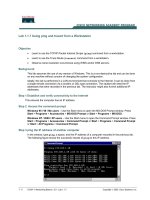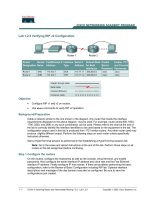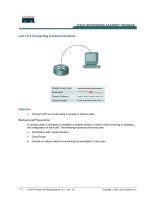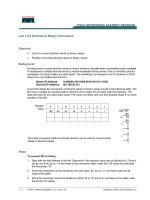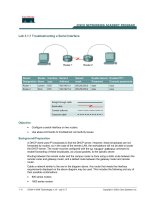Tài liệu Lab 5.2.7 Establishing a Console Connection to a Router or Switch docx
Bạn đang xem bản rút gọn của tài liệu. Xem và tải ngay bản đầy đủ của tài liệu tại đây (1.58 MB, 6 trang )
1 - 6 CCNA 1: Networking Basics v 3.0 - Lab 5.2.7 Copyright 2003, Cisco Systems, Inc.
Lab 5.2.7 Establishing a Console Connection to a Router or Switch
Objective
• Create a console connection from a PC to a router and switch using the proper cable
• Configure HyperTerminal on the PC
• Observe the router and switch user interface
Background / Preparation
This lab will focus on the ability to connect a PC to a router or a switch in order to establish a console
session and observe the user interface. A console session allows the user to check or change the
configuration of the switch or router and is the simplest method of connecting to one of these
devices.
This lab should be performed twice, once with a router and once with a switch to see the differences
between the user interfaces. Start this lab with the equipment turned off and with cabling
disconnected. Work in teams of two with one for the router and one for the switch. The following
resources will be required:
• Workstation with a serial interface and HyperTerminal installed
• Ethernet 10BASE-T or Fast Ethernet switch
• Cisco Router
• Rollover or console cable for connecting the workstation to the router or switch
2 - 6 CCNA 1: Networking Basics v 3.0 - Lab 5.2.7 Copyright 2003, Cisco Systems, Inc.
Step 1 Identify the Router/Switch console connectors
a. Examine the router or switch and locate the RJ-45 connector labeled “Console”.
Step 2 Identify the computer serial interface, which is COM 1 or 2
a. It should be a 9 or 25-pin male connector labeled serial or COM1. It may or may not be
identified.
Step 3 Locate the RJ-45 to DB-9 adapter
One side of the adapter connects to the PCs serial interface and the other to the RJ-45 rollover cable
connector. If the serial interface on the PC or dumb terminal is a DB-25, an RJ-45 to DB-25 adapter
will be needed. Both of these adapters typically come with a Cisco router or switch.
Step 4 Locate or build a rollover cable
Use a rollover cable. If necessary, make one of adequate length to connect the router or switch to a
workstation.
3 - 6 CCNA 1: Networking Basics v 3.0 - Lab 5.2.7 Copyright 2003, Cisco Systems, Inc.
Step 5 Connect the cabling components
Connect the rollover cable to the router or switch console port RJ-45 connector. Next, connect the
other end of the rollover cable to the RJ-45 to DB-9 or DB-25 adapter. Finally, attach the adapter to a
PC serial port, either DB-9 or DB-25, depending on the computer.
Step 6 Start the PC HyperTerminal program
a. Turn on the computer
b. From the Windows taskbar, locate the HyperTerminal program:
Start > Programs > Accessories > Communications > Hyper Terminal
Step 7 Name the HyperTerminal Session
At the “Connection Description” popup enter a name in the connection Name field and select OK.
4 - 6 CCNA 1: Networking Basics v 3.0 - Lab 5.2.7 Copyright 2003, Cisco Systems, Inc.
Step 8 Specify the computer connecting interface
At the “Connect To” popup, use the drop down arrow in the Connect using: field to select COM1 and
select OK.
Note: Depending on which serial port was used on the PC, it may be necessary to set this to
COM2.
Step 9 Specify the interface connection properties
a. At the “COM1 Properties” popup use the drop down arrows to select the following:
Bits per second = 9600
Data bits = 8
5 - 6 CCNA 1: Networking Basics v 3.0 - Lab 5.2.7 Copyright 2003, Cisco Systems, Inc.
Parity = None
Stop bits = 1
Flow control = None
b. Then select OK.
c. When the HyperTerminal session window comes up, turn on the router or switch. If the router or
switch is already on, press the Enter key. There should be a response from the router or switch.
If there is, then the connection has been successfully completed.
Step 10 Observe the router or switch user interface
a. Observe the user interface.
b. If this is a router, what is the prompt? ________________________
c. If this is a switch, what is the prompt? ________________________
Step 11 Close the Session
a. To end the console session from a HyperTerminal session, select the following:
File > Exit
b. When the HyperTerminal disconnect warning popup appears, select Yes.
